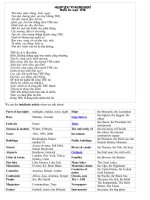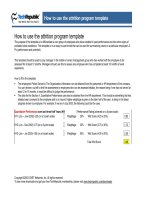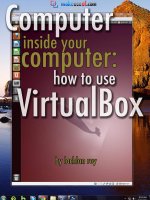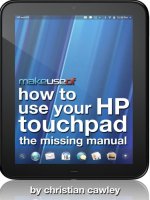Computer Inside Your Computer: How To Use VirtualBox doc
Bạn đang xem bản rút gọn của tài liệu. Xem và tải ngay bản đầy đủ của tài liệu tại đây (8.37 MB, 61 trang )
Computer Inside Your Computer: How To Use
VirtualBox
| Lachlan Roy
MakeUseOf.com
P a g e 2
Computer Inside Your
Computer: How To
Use VirtualBox
By: Lachlan Roy
Edited by: Justin Pot
This manual is the intellectual property of MakeUseOf. It must only be published in its
original form. Using parts or republishing altered parts of this guide is prohibited.
Computer Inside Your Computer: How To Use
VirtualBox
| Lachlan Roy
MakeUseOf.com
P a g e 3
Table of Contents
Introduction 4
Introduction to VirtualBox 5
What is VirtualBox? 5
Why do I want it? 5
How do I get it? 5
Using VirtualBox 6
Creating a WinXP Virtual Machine 7
Guest Additions 11
Where to go from here? 12
Creating a Windows XP VM - Picture Tutorial 13
Installing XP Guest Additions - Picture Tutorial 23
Building a Win7 Virtual Machine 26
Guest Additions 28
Where to go from here 29
Creating a Windows 7 VM - Picture Tutorial 30
Installing W7 Guest Additions - Picture Tutorial 38
Creating an Ubuntu Virtual Machine 41
Guest Additions 43
Creating an Ubuntu VM - Picture Tutorial 45
Installing Ubuntu Guest Additions - Picture Tutorial 54
Bonus Points 57
Shared Folders 57
Setting up the shared folder (regardless of guest OS) 57
Windows 57
Ubuntu 57
Conclusion 59
Computer Inside Your Computer: How To Use
VirtualBox
| Lachlan Roy
MakeUseOf.com
P a g e 4
Introduction
If only you had more computers.
You’ve heard a lot about Linux and you’d love to try it out, but you don’t know
enough to take the plunge and install it alongside Windows – maybe you’re worried
you’ll wipe all your files off in the process. Besides, you’d like to have another
computer handy so that you can look something up if you get stuck, but you don’t
have another computer. This is it.
Or maybe it’s the opposite. Perhaps you’ve taken a step out of your comfort zone
and ditched Windows – maybe for Ubuntu, or maybe for Mac OS X. You feel
liberated! No more Blue Screens of Death! You’re living life on the edge, getting on
with your work… and then you come to a screeching halt. You discover that a piece
of software crucial to your workflow runs on Windows… and only Windows.
What ever shall you do?
Does this mean that you have to go out and buy a new computer just to run this one
program? Or, as an only marginally better prospect, will you have to install it
alongside your current OS and restart every time you need to use it? Suddenly you
realise that your freedom is only as long as the chain around your ankle.
That is, until somebody introduces you to VirtualBox.
Suddenly you gain the power to conjure virtual computers out of thin air. They don’t
take up space on your desk, yet they work just like a real computer does. They can
be conjured up and removed with little more than a few clicks.
Intrigued? Read on.
Computer Inside Your Computer: How To Use
VirtualBox
| Lachlan Roy
MakeUseOf.com
P a g e 5
Introduction to VirtualBox
What is VirtualBox?
VirtualBox is a free, open source, cross-platform application
for creating, managing and running virtual machines (VMs) –
computers whose hardware components are emulated by
the host computer, the computer that runs the program.
VirtualBox can run on Windows, Mac OS X, Linux and Solaris.
This guide is based on the OS X version, but the steps are almost exactly the same
regardless of the host operating system.
Why do I want it?
Using virtual machines can be extremely useful for a number of reasons. For
example, you may want to run a virtual machine to try out software that you think
might be unsafe, or you might want to try out another operating system without
changing the way your computer is already set up.
You might also want to use it for security purposes; for example, you might want to
create a virtual machine just for online banking so that you can be sure there are no
spyware or trojans getting at your precious data.
Finally, you might want to get it because you can. VirtualBox is completely free –
there’s no reason not to download it to have a tinker!
How do I get it?
The easiest way to get the latest version of VirtualBox is to download it from the
download page of the VirtualBox website – www.virtualbox.org/wiki/Downloads.
There you can download the correct version for your platform, or if you’re using Linux
you can click through to find a list of instructions for various Linux distributions.
For each Linux distribution you’re given the option of downloading either the “i386”
or “amd64” option. “i386” is the 32 bit version, “amd64” is the 64 bit version. If you’re
not sure which version of the operating system you’re using you’re almost certainly
using the 32 bit version and so you will want to download the “i386” version of
VirtualBox.
Installing VirtualBox is just like installing any other program on your platform, so you
shouldn’t have any problem with the installation. If you do get stuck though, you
can read the installation guide on the VirtualBox website.
Computer Inside Your Computer: How To Use
VirtualBox
| Lachlan Roy
MakeUseOf.com
P a g e 6
Using VirtualBox
When you start up VirtualBox for the first time you’ll be greeted by the VirtualBox
Manager. This is where you can create virtual machines, turn them on or off and
make changes to the virtual hardware available to them.
Obviously, VirtualBox isn’t much good like this – we need to make a virtual machine!
I’ll be running through making virtual machines for Windows XP, Windows 7 and
Ubuntu, as these are the most likely candidates for a VM.
However, don’t think that these are the only options that virtual machines have to
offer. If you’re feeling brave, you might want to try one of the other Linux
distributions, such as Debian (which Ubuntu is based on), Fedora or OpenSUSE. Or
maybe Puppy Linux, or Arch Linux, or Linux Mint, or CentOS, or… well you get the
idea.
In the following sections you will learn to create Windows XP, Windows 7 and Ubuntu
virtual machines. Each step-by-step section is followed by numbered screenshots of
the steps described. Feel free to consult both the instructions and the pictures as you
build your machines.
Computer Inside Your Computer: How To Use
VirtualBox
| Lachlan Roy
MakeUseOf.com
P a g e 7
Creating a WinXP Virtual Machine
Note: the following step-by-step guide explains how to create a virtual machine.
Read these steps, then scroll down to find a step-by-step picture tutorial.
Step 1 – The first step to creating any virtual machine is to click on the
“New” button in the top left hand corner of the VirtualBox Manager
window – it’s a big blue star that’s pretty hard to miss!
This starts the “New Virtual Machine Wizard”, which will walk us through the steps
required to get a new virtual machine up and running.
Step 2 – Enter the name of the Virtual Machine. What you call it is entirely up to you –
it’s really so that you can find a specific VM easily when you have many different
VMs in the manager.
VirtualBox will try to figure out what OS you plan to run on the VM based on what
you name it. If the name of the VM has “XP” in it somewhere it assumes that you’ll be
installing Windows XP and will adjust itself accordingly. If you have a cryptic name
for it, though, don’t worry. You can manually choose the OS type from the drop-
down boxes below.
Once you’ve done that, click on “Continue” to go to the next step.
Step 3 – You’ll be asked to select the amount of RAM that you want to allocate to
the virtual machine. The more you give the VM the smoother it’ll run, but be warned;
memory allocated to the VM is memory that the host OS (that is, the computer
you’ve installed VirtualBox on) won’t be able to use.
So, how much RAM should you allocate to the VM? It depends on a number of
things. If you’re planning to use only the VM while it’s running, you can afford to give
it more RAM because you won’t be asking the host OS to be doing much
multitasking. If, on the other hand, you’ll be using the VM at the same time as doing
lots of other things on the host OS, you’ll want to be more conservative with the
amounts that you give out. However, a good general rule of thumb is to allocate
half of your computer’s RAM to the VM. So, if your computer has 4GB of RAM, give
2GB to the VM leaving the host with the other 2GB.
As far as hard numbers go, Windows XP can run well on 512MB of RAM, or if you’re
feeling generous you can push the boat out and give it a full 1024MB (1GB), so I’d
recommend allocating between these two numbers.
Time to click on “Continue” again!
Computer Inside Your Computer: How To Use
VirtualBox
| Lachlan Roy
MakeUseOf.com
P a g e 8
Step 4 – The next step is to create a “Virtual Hard Disk” (VHD). This creates a file on
your hard drive which can be used by VirtualBox to act like its own separate hard
drive, allowing you to install an operating system without worrying about wiping over
your existing data.
Make sure that “Boot Hard Disk” and “Create new hard disk” are selected, then click
“Continue”. This will start the “Create New Virtual Disk Wizard”. Click “Continue”
again to proceed.
Next you’ll be asked if you want to create a “dynamically expanding” disk (which I’ll
call a dynamic disk from now on) or a “fixed size” disk. Each has its own benefits.
The great thing about a dynamic disk is that it’s only as large as the data that it has
on it; you can assign it plenty of space without having to worry about whether you’ll
use it or whether you’ll run out of space. They’re also a lot faster to create than a
fixed disk of any significant size.
However, you’ll need to keep an eye on it, because its flexibility can also be its
downfall. Say you create a dynamic disk and assign it 50 GB, then put about 20GB
of data on it. The dynamic disk file will show up as taking only 20GB of space on the
hard drive according to your host OS. Great. You fill up the rest of the free space on
your physical hard drive.
Thing is, if you start up the VM and try to add more data to the dynamic disk, you’ll
run into trouble – the virtual disk says that it’s still got 30GB free, but there’s nowhere
to actually put that 30GB of data. The VM freaks out, thinking that the hard drive is
failing, but that’s not true. It just needs some more breathing room on the physical
drive to store the data it’s been told it’s able to save.
This is the advantage of the fixed size disk. Sure, it’s inconvenient when you’re trying
to figure out how much space to give it, but once it’s been made you won’t have to
worry about it ever again.
In this example we’ll be using dynamic disks, but fixed disks will work just as well.
Make sure that “Dynamically expanding storage” is selected, then click on
“Continue” again.
Next you’re asked to choose the name, location and size of the new VHD. For most
uses you won’t need to change the name or the location, but you can do this by
clicking on the folder icon next to the text box.
The size you should make the VHD depends on how much stuff you plan to put in it,
but if you’re using a dynamic disk it doesn’t really matter if you allocate it lots of
Computer Inside Your Computer: How To Use
VirtualBox
| Lachlan Roy
MakeUseOf.com
P a g e 9
space. If you’re just using it to run a few programs, the suggested size of 10GB should
be plenty! Make sure the settings are right then click “Continue”, then “Done”.
Step 5 – At this point all you need to do is check over everything and make sure all
the settings are as you expect them to be. Then you just need to click “Done” and
the VM will be created, ready for you to install Windows!
Step 6 – Now it’s time to start up the VM for the first time. Make sure that the new
virtual machine that you just created is selected in the VirtualBox Manager window,
then click on the “Start” button at the top of the window.
Step 7 – When the VM starts up you’ll be greeted by the “First Run Wizard”, which will
guide you through getting ready to install Windows XP. Click “Continue”.
It’ll then ask you what you want to use for installation media; that is, whether you
want to install it using a CD and the host’s optical drive, or whether you want to
install it from a disk image on your hard drive (usually in the form of a .iso file). You
can choose the former from the drop down menu or the latter by browsing for the
.iso file (using a standard “open file” dialog). Once you’ve chosen the installation
media, click on “Continue”, then “Done” after reading the summary.
Step 8 – Since there isn’t anything installed on the virtual hard disk the virtual
machine will automatically boot from the CD into Windows Setup. It’ll take a while
for setup to load all the files it needs, but eventually you’ll see a screen that shows a
list of the existing partitions and unpartitioned space on the computer. In the list all
you’ll see is an “Unpartitioned space” the size of the VHD you created in Step 3. You
want to set up XP here, so press “ENTER”.
You’ll then be asked how you want to format the drive. You’ll most definitely want to
choose the option “Format the partition using the NTFS file system (Quick)”. Make
sure you choose the “Quick” option or you’ll be waiting for a very long time!
That’s all you’ll need to do for a little while – Windows Setup will format the VHD then
start copying files to the drive. You can sit and watch or go get a cup of coffee; it
doesn’t really matter. Once it’s finished copying files Windows Setup will
automatically restart your computer to proceed to the next step.
Step 9 – When the computer restarts it will try to boot from the CD first, saying “press
any key to boot from CD…”. Ignore this! If you do this you’ll be doing step 7 all over
again for no reason. You can prevent this from happening again by right clicking the
CD icon at the bottom of the VM window and clicking “Remove disk from virtual
drive”. Once it passes, you’ll see the familiar Windows XP booting screen before the
screen switches to the second stage of installation.
You’ll probably see a dialog box come up a few times during the installation about
the guest OS not supporting “mouse pointer integration”. Don’t worry about this – tell
it not to show the option again and then click OK to dismiss it.
Computer Inside Your Computer: How To Use
VirtualBox
| Lachlan Roy
MakeUseOf.com
P a g e 10
You’ll be waiting for a little while longer, until…
Step 10 – The “Windows XP Setup Wizard” will pop up. Click “Next” to get started.
First you’ll be asked to set your regional and language options, which basically
involves clicking on “Customize…” to choose your country and then “Details” if you
need to change your keyboard layout. Once that’s sorted, click “Next” again.
Next you’ll need to enter in a computer name and an Administrator password. I’d
suggest a name that is actually useful instead of the random string of characters
produced automatically. How complex you want to make the administrator
password is up to you, depending on how important the security of the VM is.
After clicking “Next” you’ll see the date and time settings, which you shouldn’t have
to change. Clicking “Next” again will make the window disappear for a while as
Windows applies all the settings and continues with the installation.
After a minute or two goes by another window will pop up, this time for network
settings. You’ll almost certainly want to select the first option (a network that has no
domain). It requires that you enter the name of a workgroup – the default
workgroup name for Windows XP computers is “WORKGROUP”. Enter that into the
text box and then click “Next”.
That’s it for Windows Setup! It’ll take a few minutes for Windows to finalise the
installation, then it will restart automatically once more when it’s finished.
Step 11 – We’re at the last step for installing Windows XP itself. Now we just need to
enter in some final details like networking and creating a username.
As Windows starts up again a dialog box will pop up saying that it will adjust the
screen resolution to approve the appearance of visual elements. Just click “OK”
then “OK” again on the next window that pops up to confirm the change.
Now you’ll see the “Welcome to Windows” screen. Click “Next” in the bottom right
hand corner of the screen to get started.
You’ll be asked if you want to use Automatic Updates; you most certainly do! Make
sure the first option is selected before clicking “Next”.
The way that VirtualBox provides a network connection to the VM means that you’ll
definitely want to choose the first option (“Yes, this computer will connect through a
local area network or home network”). Make sure that’s selected, then click “Next”.
There’s little point in registering with Microsoft, so click No, then “Next”. In the next
step you’ll be asked to enter in a username – enter one then click “Next”. After that
you just need to click “Finish”, then you’re all done!
Computer Inside Your Computer: How To Use
VirtualBox
| Lachlan Roy
MakeUseOf.com
P a g e 11
You’ll see the “welcome” screen, and then the familiar Windows XP desktop. Great!
You’re all done with installing Windows. However, we’re not done yet! Go to the
VM’s start menu and shut it down, because there’s one thing left to do; installing
VirtualBox’s “Guest Additions”.
Guest Additions
“What are Guest Additions?” I hear you ask. The Guest Additions are a set of drivers
and software which comes with VirtualBox to make using VirtualBox in conjunction
with the host computer a little easier. Installing Guest Additions isn’t compulsory at
all, but it’s most definitely recommended.
There are a few features that you’ll get by installing Guest Additions. The main one is
called mouse pointer integration. You may have noticed that when using the VM
you had to click inside the window for the VM to detect any mouse movements (or
to type), and that you needed to press a specific key (called the host key) to
release the mouse and keyboard so that you could use them with the host
computer again.
With mouse pointer integration, you no longer have to click inside the window to use
your keyboard and mouse in the VM or use the host key to release them. As you
move your pointer over the window it is automatically “captured”, and it is
automatically released when the pointer reaches the edge of the window. This by
itself is worth installing Guest Additions for!
The second main feature is shared folders. This basically allows folders on your host
machine to show up as network shares on the guest OS, allowing you to access files
which would otherwise be inaccessible.
There are other useful features like better video support and seamless windows – you
can read more about them in the VirtualBox documentation.
To install Guest Additions properly, you’ll need to start Windows XP in Safe Mode. This
basically means that Windows starts up running nothing but the bare essential
drivers. In this mode, VirtualBox is able to install its Guest Additions without messing
with drivers which would otherwise be in use.
Step 1 – Before you start there’s a couple of settings you’ll need to change. Make
sure that the Windows XP VM is selected in the VirtualBox Manager, then click on the
“Settings” button between “New” and “Start”.
Computer Inside Your Computer: How To Use
VirtualBox
| Lachlan Roy
MakeUseOf.com
P a g e 12
You’ll want to go to the “Display” tab. There you’ll want to give the VM at least 32MB
of video memory; ideally, you’ll want to allocate 64MB. You’ll also want to enable
both 3D and 2D Video Acceleration.
Step 2 – It’s time to start up the VM again. To start Windows up into Safe Mode, you’ll
need to constantly press F8 (Fn+F8 on a Mac and some Windows laptops) until you
see the “Windows Advanced Options Menu”. Here you’ll want to select Safe Mode
using the arrow keys and then press Enter.
You’ll see a long list of seemingly random text – this is a list of the exact drivers that
Windows is loading to be used in Safe Mode. Windows will boot after this.
Step 3 – Once you’ve logged in as Administrator, a window mentioning Safe Mode
will pop up; it’s safe to dismiss it straight away.
Now, go to the Devices menu for the VM; on OS X this can be found in the menu bar
while the VM window is selected, or for Windows/Linux it will be at the top of the VM
window itself (you might have to press the “alt” key to reveal it). Here you’ll see an
option labelled “Install Guest Additions…”. Clicking on this will mount an .iso file as a
CD on the VM.
Step 4 – Once the Guest Additions CD has been mounted the setup wizard should
automatically pop up. If it doesn’t, go to “My Computer” and click on the CD to
start it (which should be D: by default).
The setup is fairly straightforward, and all the default values are good. You might
want to select “Direct3D Support” when asked to choose components, though.
While chances are you won’t be using the VM for anything that actually uses
Direct3D, you might as well have it installed now rather than having to do this all
again later if you do need it for some reason.
After finishing the installation you’ll be asked to reboot the computer. That’s it! When
you restart the computer allow it to boot normally. You should be logged
automatically into the standard account and able to actually start using the VM like
a normal computer.
Where to go from here?
Having said that, just like any new computer you’ll need to get some software to
make your computer actually usable. A new browser and anti-virus/malware
software are the basics, but there are other things too, like a PDF reader, multimedia
software (saving you from having to go back to your host OS to watch the odd
video or listen to the odd song).
Computer Inside Your Computer: How To Use
VirtualBox
| Lachlan Roy
MakeUseOf.com
P a g e 13
You could go hunt down the software individually, which is fine – I recommend
Google Chrome, Avast’s Free Antivirus and MalwareBytes Free Anti-malware.
You could do that, or you could download a package with everything you need to
get started that installs in one go. Interested? Check out the MakeUseOf Pack: a
handful of really useful Windows apps.
Creating a Windows XP VM - Picture Tutorial
1
2
Computer Inside Your Computer: How To Use
VirtualBox
| Lachlan Roy
MakeUseOf.com
P a g e 14
3
4
Computer Inside Your Computer: How To Use
VirtualBox
| Lachlan Roy
MakeUseOf.com
P a g e 15
Computer Inside Your Computer: How To Use
VirtualBox
| Lachlan Roy
MakeUseOf.com
P a g e 16
5
6
Computer Inside Your Computer: How To Use
VirtualBox
| Lachlan Roy
MakeUseOf.com
P a g e 17
7
Computer Inside Your Computer: How To Use
VirtualBox
| Lachlan Roy
MakeUseOf.com
P a g e 18
8
9
Computer Inside Your Computer: How To Use
VirtualBox
| Lachlan Roy
MakeUseOf.com
P a g e 19
10
Computer Inside Your Computer: How To Use
VirtualBox
| Lachlan Roy
MakeUseOf.com
P a g e 20
Computer Inside Your Computer: How To Use
VirtualBox
| Lachlan Roy
MakeUseOf.com
P a g e 21
11
Computer Inside Your Computer: How To Use
VirtualBox
| Lachlan Roy
MakeUseOf.com
P a g e 22
Computer Inside Your Computer: How To Use
VirtualBox
| Lachlan Roy
MakeUseOf.com
P a g e 23
Installing XP Guest Additions - Picture Tutorial
1
2
Tap F8 to
get
Computer Inside Your Computer: How To Use
VirtualBox
| Lachlan Roy
MakeUseOf.com
P a g e 24
3
4
Computer Inside Your Computer: How To Use
VirtualBox
| Lachlan Roy
MakeUseOf.com
P a g e 25









